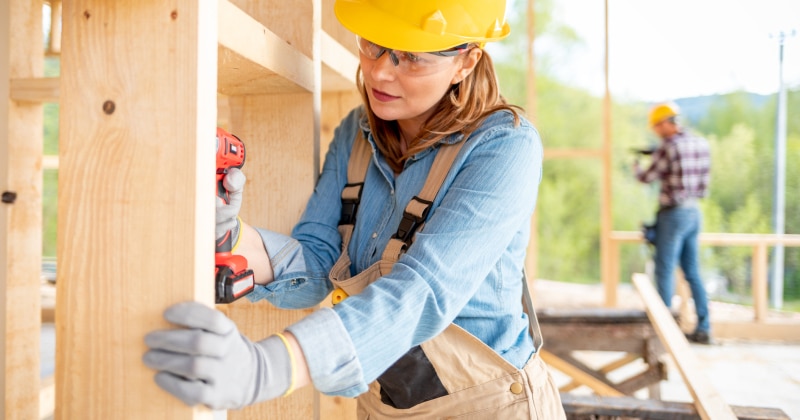19 Women in Construction Statistics for 2022
Construction has long been a field dominated by men, but now that’s starting to change. In this article, read the latest statistics about women in construction to learn more about their industry role.

Managing Editor
For most of its history, the construction industry has been dominated by men. The industry is also growing, and a lack of skilled workers is a concern for many home services providers.
So, who do we have to help fill this gap? Women.
Women are reshaping the construction industry, and we have the facts to prove it. To get a better idea of what the future of the construction business holds and the role of women in it, we’ve gathered some compelling stats.
In this article, you’ll learn all about women in construction—not only where female construction workers stand today, but also where they’re headed in the future. Keep reading to explore 30+ facts focused on women in construction in 2022.
The Current Role of Women in Construction
Key Statistics
- Women make up 11% of employed construction workers. (U.S. Bureau of Labor Statistics)
- The percentage of women in construction has been increasing since 2016. (Statista)
- Most women in construction (35%) work in administrative or office roles. (U.S. Bureau of Labor Statistics)
- In many small and mid-sized cities, women make up more than 11% of construction workers. Examples include Sandy Springs, GA, and Tallahassee, FL, both with nearly 31% women construction workers. (Construction Coverage)
It’s no surprise that women make up a tiny fraction of the construction workforce. According to the U.S. Bureau of Labor Statistics (BLS), 11% of construction workers are female.
But that percentage has been steadily increasing since 2016.
A spike of women in the industry could also be coming with younger generations. Considering the demand for construction and workers, the field could be very appealing.
The BLS also says that most women in construction have administrative or office jobs. Most of those are sales and office roles.
That said, many women also have more active on-site jobs. The days of only men doing the hard work are fading as society moves away from more outdated gender roles. Women can do physical labor just as well as their male counterparts.
In fact, many small and midsize cities have a construction workforce made up of more than 11% of women. Some of these include Sandy Springs, GA (30.7%), Burbank, CA (25.5%), Tallahassee, FL (30.8%), Mobile, AL (28.7%), and Little Rock, AR (22.7%).
So, what’s the opportunity for women in construction now and in the future?
Construction Workers Are in High Demand
Key Statistics
- The construction workforce shortage is projected to be over 650,000 workers in 2022. (Associated Builders and Contractors)
- 402,000 construction worker positions were still unfilled at the end of October of 2021. (McKinsey)
- The number of construction workers aged 25-54 has declined by 8% over the last decade. (Associated Builders and Contractors)
Smaller home services providers are feeling the pressure of demand and labor challenges.
By the end of October 2021, over 400,000 positions were still unfilled. And the Associated Builders and Contractors (ABC) predicted that there would be a workforce shortage of over 650,000 in 2022.
ABC’s president and CEO, Michael Bellaman, has commented on the significant need for more construction workers.
The construction industry desperately needs qualified, skilled craft professionals to build America.
Michael Bellaman, abc president & ceo
This gap is bound to have an impact on women in construction.
He also noted that demand would only increase with the passage of the Infrastructure Investment and Jobs Act.
The ABC study also noted the decline in the number of workers aged 25-54, which fell by 8% over the last decade.
Many construction companies have been trying to solve this decline by focusing on the field as a career, not a job. They’re emphasizing the earning potential and other benefits like long-term job security, flexibility, and the ability to advance in your career.
Another point that may make construction a more attractive industry is that construction jobs are becoming more technical in nature. These roles look different than construction from decades ago, which could spur more interest.
Experts at McKinsey recommend that construction companies begin recruiting early by partnering with high schools, trade schools, and community colleges. They also suggest focusing more on skills than credentials.
There are approximately 106 million workers who don’t have a four-year degree but have built up a skillset through experience.
With all this opportunity to boast of, construction companies should also focus on attracting women. One idea is to partner with women’s organizations, like the National Association of Women in Construction (NAWIC) and Women Construction Owners & Executives USA. They have mentorship programs and networking opportunities.
Why Is Having Women Construction Workers Important?
Key Statistics
- Companies with more gender diversity are 25% more likely to have higher than average profits. (McKinsey)
A diverse company is a successful one—and the data backs it up. According to research, gender-diverse companies are 25% more likely to generate above-average profitability than those that are less diverse.
Diversity is good for business.

Women in Construction 2022 Statistics to Know
Now that we’ve reviewed the current state of women in construction and the industry’s considerable labor gap, let’s look at some other notable women in construction statistics for 2022.
Job Type Statistics
Key Statistics
- The most common job positions for women in construction are Office Administrator (25%), Manager (18%), and Administrative Assistant (10%). (Levelset)
- Only 2% of women report holding the role of Tradesperson or Laborer. (Levelset)
- Between 2015 and 2019, the role of Construction Manager was the third-fastest growing job for women in the U.S. (SmartAsset)
- 1% of women in construction surveyed reported having female company leadership. (Levelset)
What jobs do most women hold in construction? According to 2021 survey data, the top category is Office Administrator, followed by other office roles, such as Manager or Administrative Assistant.
In fact, Construction Manager was the third-fastest-growing job for women, according to a study by SmartAsset. Unfortunately, still only 1% of women construction workers surveyed had female company leadership.
In the same survey, only 20 women said they were a Tradesperson or Laborer. The lack of women construction workers does, however, leave a lot of room for workforce growth.
See the top woman-owned plumbing companies.
Hurdles Women in Construction Face
Key Statistics
- Women in construction make 87 cents for every dollar made by men. (Narrow the Gap)
- The construction pay gap is even worse for women of color, who only make 81 cents to the dollar compared to men. (360 Recruitment)
- The biggest challenge ranked by women in the construction industry is earning respect. (Levelset)
- Female construction workers can earn 30% more than those in other woman-dominated fields. (360 Recruitment)
- 50% of women in construction surveyed say they’ve experienced gender discrimination. (Levelset)
- 60% of women in construction in the same survey responded that they received inappropriate comments occasionally or regularly, but 83% felt if they reported harassment, their supervisor would support them. (Levelset)
- In 2022, 54% of women said they had networking opportunities. (Levelset)
- 86% of women surveyed reported that their company would support opportunities for them to receive more training. (Levelset)
Although women are slowly making up a larger part of the construction industry, their progress is not without its challenges. Let’s take a look at some of the biggest obstacles women in construction face in 2022.
The Pay Gap and Earning Potential
Like most industries, there is a large pay gap between women and men in construction. Women earned only 87 cents to the dollar in 2020 compared with men, and women of color fared even worse at 81 cents to the dollar.
Much of this pay discrepancy has to do with respect.
In fact, earning respect was the number-one challenge named by women surveyed in the construction industry. One respondent was quoted as saying, “The most challenging part of working in the construction industry as a woman is earning the same amount/an ounce of respect men get for doing the same thing.”
One bright spot around pay, though, is that women working in construction can earn 30% more than those in other jobs. This can be a good talking point to encourage women to embark on a construction career.
Respect and Equality
50% of respondents in a survey of women in construction said they’ve experienced discrimination because of their gender. Another 60% reported that inappropriate comments occur occasionally or even regularly.
However, 83% said that if they reported harassment, they believed they would have the support of their supervisor.
Regardless, construction companies must work toward ending discrimination to keep their women workers.
Support and Mentorship
In the same survey, most women felt positive about their support systems and opportunities to be mentored.
Over 50% said they had opportunities to network with women. Additionally, over 80% said their company would support training opportunities for them.
It’s critical for women to see representation at the management and executive level. Without it, more women will leave the field, believing there’s no opportunity for advancement.
Women in Construction: How They Feel About Their Career
Key Statistics
- 80% of women in construction love their job. (Levelset)
Despite the challenges they face, a 2022 survey found that 80% of women in construction love their job.
Why? Because they’re able to work as a team, they’re always learning something new, it’s never boring, and they’re helping to build communities.
These insights could be critical in helping to recruit more women to the industry.
Demographics of Women in Construction
Key Statistics
- Most women in construction are aged 35-44. Women under 24 have some of the lowest representation. (Levelset)
- The highest level of education for most women in construction is a bachelor’s degree. (Levelset)
Data shows that women in construction tend to fall between the ages of 35 and 44, with younger women under the age of 24 having very little representation.
Most female construction workers also hold a bachelor’s degree.
Data shows that women in construction tend to fall between ages 35 and 44, with younger women under 24 having very little representation. Most female construction workers also hold a bachelor’s degree.

Retention Statistics
Key Statistics
- Over 44% of women working as tradespeople say they’ve considered quitting their job because of unequal treatment. (Institute for Women’s Policy Research)
- Female construction workers feel a lack of support during pregnancy and maternity leave. (Institute for Women’s Policy Research)
- Local unions, organizations, and trade programs are where women in construction find the most support. (Institute for Women’s Policy Research)
Do women stay in construction careers?
According to a study published by the Institute for Women’s Policy Research (IWPR), which surveyed tradespeople, unequal treatment is the top reason women would leave their jobs. Over 44% of respondents said they’ve considered quitting because of unequal treatment, defined as a lack of respect and discrimination.
Another key issue in keeping women in the construction industry is a lack of support during pregnancy and maternity leave.
Female construction workers are frustrated by how hard it is to find childcare and that their companies don’t make accommodations for pregnancy. These issues make them feel isolated and can lead to them exiting the field.
When women in construction want to stay, they find support through local unions, organizations, and trade programs.
Women also feel more included when their workplace has anti-harassment policies and a commitment to diversity.
Women in Construction Is Good for All
Having more female construction workers benefits everybody in the industry.
Welcoming women into construction companies can help manage labor gaps, and increased diversity has proven to make those companies more successful.
Plus, when construction is healthy, it also helps the overall economy. More diversity in the construction industry is good for women, too, as they can have job security and increase their earnings.
Greater representation of women in the construction field also feeds into the next generation of workers. Young girls that see that women can succeed in the industry enable them to consider this as a possibility for their future.
Although there are still challenges, current statistics paint a picture of how fulfilling a career for women in construction can be. Ultimately, for construction to be a sustainable field in the future, adding more females is a must.
When all is said and done, common sense and data prove that more women in construction will only improve the field.
Melissa can masterfully bring to life any form of content, whether it’s a landing page or a guide to befriending gnomes. When she’s not crafting stories, she’s either crocheting, smothering her cats in unwelcome affection, or spending time with her husband.

Business Solutions For Field Service Pros
EverPro offers specialized solutions designed for home and field service professionals. We’ve got the business tools to help you get the job done.



